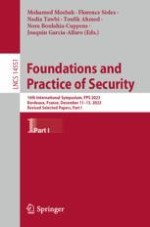2024 | Buch
Foundations and Practice of Security
16th International Symposium, FPS 2023, Bordeaux, France, December 11–13, 2023, Revised Selected Papers, Part I
herausgegeben von: Mohamed Mosbah, Florence Sèdes, Nadia Tawbi, Toufik Ahmed, Nora Boulahia-Cuppens, Joaquin Garcia-Alfaro
Verlag: Springer Nature Switzerland
Buchreihe : Lecture Notes in Computer Science
